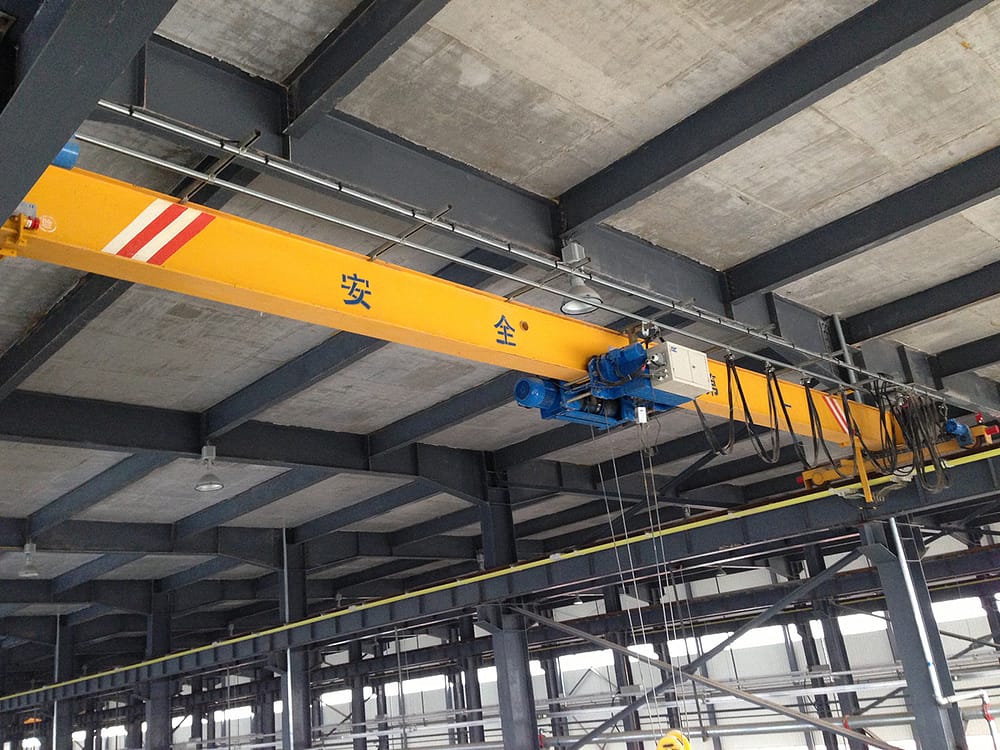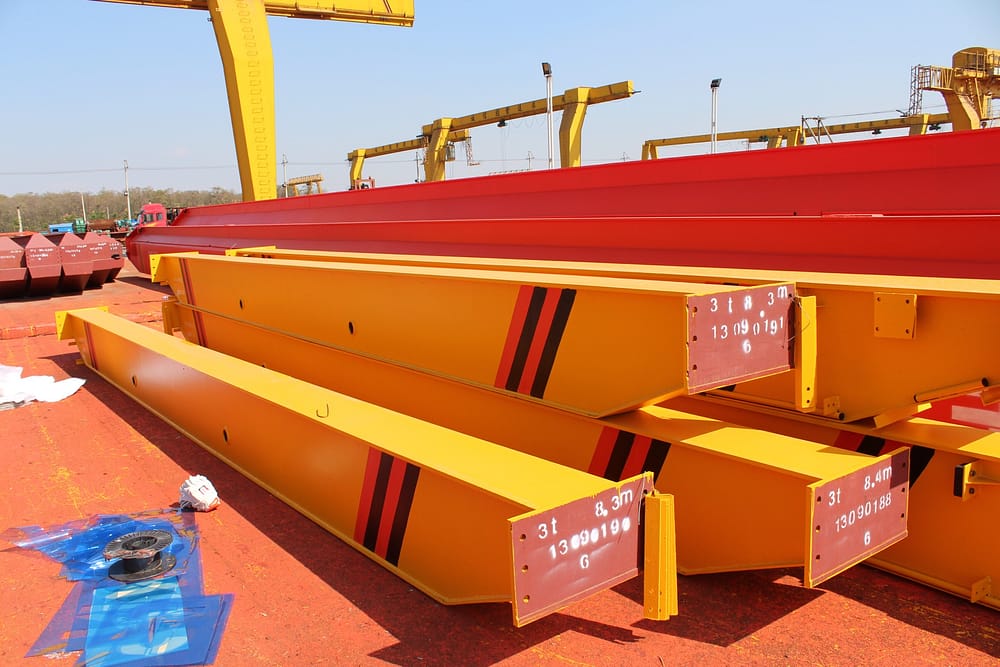How To Design A Single Girder Overhead Crane
If you’re considering building or purchasing an overhead crane, there are many factors to consider. One of the most important is the design of the crane itself. In this article, we’ll focus specifically on how to design a single girder overhead crane. By the end of this article, you should have a better understanding of what goes into designing a single girder crane and be able to make an informed decision about which type of crane is right for your needs.
What Is A Single Girder Overhead Crane?
Before we dive into the design of a single girder overhead crane, it’s important to understand what exactly it is. An EOT crane is a type of material handling equipment that uses a horizontal beam, known as a girder, to move heavy objects. The girder is supported by vertical columns, and the crane moves along this gantry structure to position the load precisely where it needs to be.
A single-girder overhead crane has just one girder that spans the width of the crane. This design is typically used for lighter loads and shorter spans than double girder cranes.

The Composition Of Single Girder Overhead Crane
Single-girder overhead cranes are commonly used in factories, warehouses, and other industrial settings to lift and move heavy loads. The EOT crane consists of several key components, including the bridge, hoist, trolley, and controls.
The bridge, also known as the gantry, is the primary support structure for the crane. It consists of a single beam that spans the width of the workspace and is supported at either end by a pair of vertical columns or runway beams. The bridge is designed to carry the weight of the hoist and trolley as they move along it.
Mounted on the bridge is the hoist, which is the device that actually lifts and lowers the load. The hoist typically consists of a motorized drum or chain that pulls a cable or chain attached to the load. The hoist may be operated manually or with a powered mechanism, such as an electric motor.

Attached to the hoist is the trolley, which allows the load to be moved horizontally along the length of the bridge. The trolley runs on rails that are mounted on top of the bridge and are typically powered by a separate motor.
The entire crane system is controlled by an operator using a set of controls located near the bridge. The operator can control the movement of the hoist, trolley, and bridge to precisely position the load as needed.
Factors To Consider When Designing A Single Girder Overhead Crane
1.Determine The Load Capacity
In order to determine the load capacity, the first step is to calculate the weight of the hoist and trolley. This can be done by referring to the hoist manual or by consulting the manufacturer. In addition to the weight of the hoist, the weight of additional components such as cables or chains also needs to be taken into account. The next step is to calculate the weight of the load to be lifted. The load capacity must not be less than the weight of the lifting mechanism plus the weight of the load.
2. Select The Appropriate Beam Size And Type
One of the most important considerations when selecting a beam size is the weight capacity of the crane. It’s crucial to choose a beam that can handle the heaviest load that will be lifted while also factoring in any potential future increases in load capacity. Overloading a crane can lead to serious accidents, so it’s essential to err on the side of caution and choose a beam with a higher weight capacity than what is currently needed.
Another factor to consider is the span of the crane. The span refers to the distance between the runway rails, and it’s important to choose a beam size that can effectively support the span without sagging or buckling under the weight of the load. For longer spans, a larger beam size may be required to provide the necessary strength and stability.
In addition to the beam size, the type of beam is another important consideration. There are various types of beams available, each with its own advantages and disadvantages. For example, an I-beam is a popular choice because it offers excellent strength and durability, while a box beam can provide additional torsional rigidity. Other options include truss girders, tapered beams, and built-up beams.

3. Choose The Hoist And Trolley
There are two main categories of hoists: electric and manual. Electric hoists are powered by electricity and can lift heavier loads than manual hoists. They are also more expensive as electric hoists require additional components for power supply. Manual hoists are operated physically and are more suitable for lifting lighter-weight loads.
Load capacity is a fundamental factor to consider when choosing a hoist. It is important to choose a hoist with a load capacity that matches the weight of the load. If you choose a hoist with a lower load capacity than the load, you risk damaging the hoist and compromising safety. Conversely, if you choose a hoist with a higher load capacity than the load, it will be less cost-effective.
Trolleys are also an important part of the hoist system. There are several types of trolleys available, including manual, geared and electric options. Manual trolleys are the most basic type of trolley and operate by pushing or pulling the load along the track. Geared trolleys have a gear mechanism for easier movement, and motorised trolleys are powered by electricity and can move loads more quickly and efficiently.
4. Select The Appropriate Single Girder Overhead Crane Controller
There are two main types of control systems: pendants and radio remotes. Pendant systems use a handheld pendant that is connected to the crane via a cable, while radio remote systems use a wireless transmitter to control the crane.
When choosing a control system, it’s important to consider the environment in which the crane will be operating. If the crane will be used in a high-temperature environment, for example, a radio remote system may be more suitable as there are no cables that can easily melt or be damaged by heat. On the other hand, if the crane will be used in a dusty environment, a pendant system may be better as it is less likely to be affected by dust and debris.
Safety is also a critical factor to consider when selecting an EOT crane controller. The controller should have safety features such as overload protection, emergency stop buttons, and anti-collision sensors to prevent accidents and injuries.
5.Determine The Motor Power
To determine the EOT crane motor power, we would need more information such as the weight of the load to be lifted, the distance the crane needs to move, and any specific requirements or constraints that need to be considered.
The motor power is typically calculated based on the weight of the load, the distance the crane needs to move, and the desired speed of the crane.
To calculate the required motor power, the following formula can be used:
Motor Power = (Weight of Load x Distance)/(Time x Efficiency)
Where:
Weight of Load: The weight of the load to be lifted
Distance: The distance the crane needs to move
Time: The time required for the crane to complete the movement
Efficiency: The efficiency of the system, which takes into account losses due to friction and other factors
Once the required motor power is calculated, the appropriate motor size can be selected based on the manufacturer’s specifications and any specific requirements of the application.
6.Choosing Appropriate Materials And Coatings
One important consideration when selecting materials for an EOT crane is the weight of the loads it will be handling. Cranes that are used to lift heavy loads will require stronger materials, such as steel or aluminium, to ensure they can support the weight without bending or breaking.
There are several different types of coatings that can be used on bridge cranes, including epoxy coatings, zinc-rich primers, and polyurethane coatings.
7.Ensure Compliance With Safety Standards
The design of single-beam bridge cranes must comply with the relevant national and industry standards, such as GB/T 3811-2008 and JB/T 1306-2008. These standards specify the requirements for the design, manufacture, installation, and testing of the crane components.
Designing a single girder overhead crane requires careful consideration of various factors such as load capacity, beam size and type, hoist and trolley, bridge speed and motor power, and safety standards. By following these steps and consulting with experienced professionals, you can ensure that your single girder overhead crane is safe, efficient, and meets your business needs.
Send Your Inquiry
- Email: sales@hndfcrane.com
- WhatsApp: +86-191 3738 6654
- Tel: +86-373-581 8299
- Fax: +86-373-215 7000
- Add: Changnao Industrial District, Xinxiang City, Henan Province, China









































































